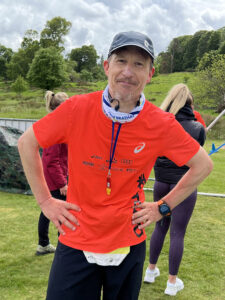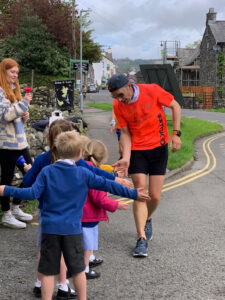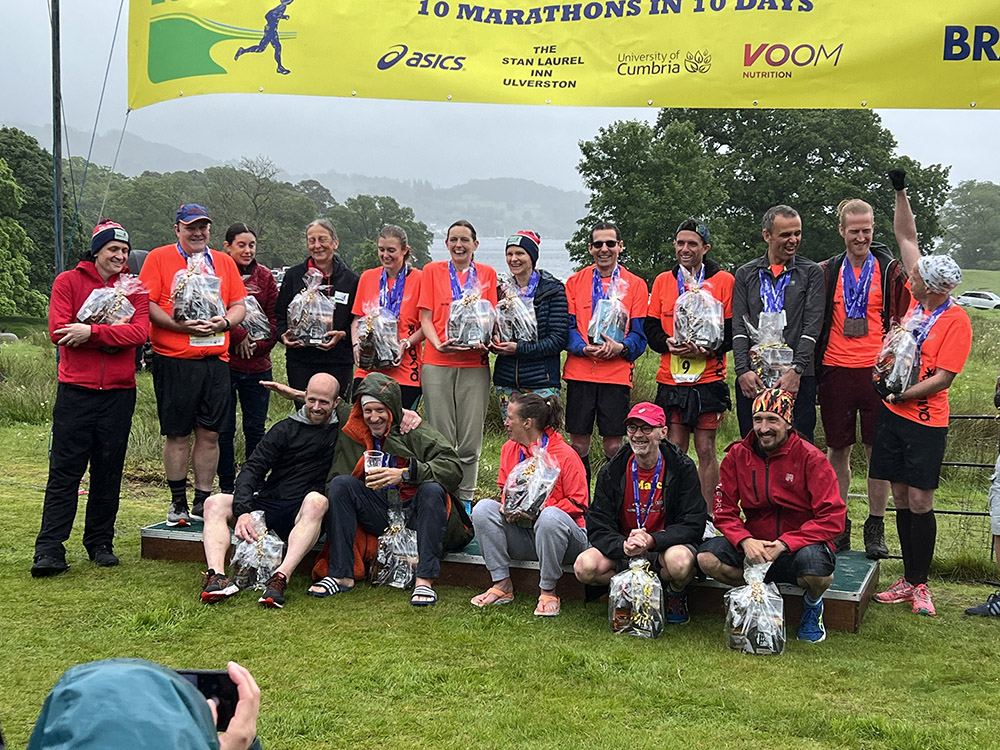Committing to the Brathay 10in10
I have no interest in doing just one road marathon again. But I’d do the Brathay 10in10 again. That probably sounds counterintuitive—that I’d rather do 10 road marathons in 10 days than one in a single day—but the commitment and endurance demanded by the former attract me far more than the idea of pushing myself as hard as possible over 26.2 miles.

I was inspired to sign up for the Brathay 10in10 after becoming a trustee of the Brathay Trust, a charity dedicated to using interventions—including outdoor activity—to improve the life chances of young people who are in some way disadvantaged, by giving them confidence and a sense of self-belief. My primary goal was to raise a lot of money for the organization; COVID had hit its income streams very hard. I was also curious to see if my body could handle something as unappealing as running 10 marathons in 10 days. Road running has never been my main passion—I prefer any activity that involves a lot of (slow) uphill: ski touring, trail running, cycling—but I thought the 10in10 sounded like a wonderful test of endurance. I’d have to motivate myself to get up every day and do the same thing I’d done the day before.
The Brathay Trust is based on the shores of Windermere, a lovely lake in England’s famous Lake District. Every year, the trust puts on a number of endurance events, among them the 10in10: 10 marathons in 10 days, each one run on the same anticlockwise course around Windermere.
Knowing this event was going to be much harder than anything I’d attempted to date, I reached out to Uphill Athlete for bespoke training. I’d followed the Mike Foote Big Vert program to prepare for the 2019 Ultra Tour Monte Rosa, a trail running stage race, and I appreciated the UA philosophy and approach. (I’d read a lot of Phil Maffetone’s work, which got me interested in the essence of the MAF method, which then led me to Training for the New Alpinism and Training for the Uphill Athlete. Those books were completely life-changing for me.) For the 10in10, I would need more discipline and rigor, more help building the training around my busy lifestyle and in a way that could incorporate other athletic events. Pedro Carvalho began coaching me about nine months out from the start of the 10in10.
I told him that I didn’t want to break a particular time, and I didn’t want to completely break myself. I’m an average Joe athlete and runner—not especially fast or talented, just eager to test my endurance and spend time outside. Longevity matters far more to me than trying to set a new personal best. Pedro got me ready for a big cycle race in Belgium about six weeks before the 10in10, and I felt brilliantly prepared for that as well as for the run. And when I got COVID twice during the training, he immediately adapted the program. It was fascinating to watch my fitness deteriorate but also to see the benefit of having an aerobic base. Without him I suspect I would have gone back to training too quickly, and it would have made a massive difference.
Overall, it was a great learning experience. I gained a better understanding of my own physiology and when to push and when not to push. I started listening to my body and paying attention to my resting heart rate. And I came to embrace the value of periodic training, of building volume and intensity strategically and not overdoing it the whole time.
By the time I arrived at the Brathay Trust headquarters in Cumbria in May, I felt well prepared aerobically. Nineteen of us had committed to doing the 10in10 in 2022, and we would all stay at the trust for the duration of the event. We’d have our meals together and our physio on-site. It would be a very intimate, collective experience. I’d only met them once before, during a group training weekend, and had found that we were all very different—different backgrounds, different levels of athletic ability, different goals—but the environment of mutual support proved to be invaluable.
I ran too fast on the first day, finishing the circuit in 4 hours, 21 minutes. But each subsequent day felt calmer, steadier, with my times falling within a 12-minute range, from 4 hours, 28 minutes to 4 hours, 40 minutes. I went without a heart rate monitor and found that I was able to calibrate my pace by feel. I targeted a certain time per mile and just built it up mile by mile.

Repetition and consistency were key to everything, not just my pacing. I tried to be predictable. The race started at 9:30 each morning; I got up at six because it took a full hour of mobility work and light cycling to coax my body from crawling to walking. Fueling myself properly in the morning was also a battle, as the pre-race foods that I would normally have found appealing simply weren’t. It was very hard to get enough energy into my body each day.

The first 5 miles were always difficult. Then my body would adapt to another circumnavigation of the lake, and it was just a matter of keeping that rhythm. Because of the training, my aerobic and muscular endurance were completely fine, not an issue at all. However, my lack of experience with road running—I’d only run one road marathon before, back in 2003—manifested in ankle and Achilles troubles: I struggled with compression and fluid buildup that inhibited my mobility. Without that, I probably could have run faster each day.
The mental piece was far more challenging. After the first three or four days, I knew the route very intimately, the good bits and the bad bits. I was familiar with the sharp right-to-left camber of the road, and I could anticipate each climb that contributed to the 800 meters of daily ascent. That’s where it made a massive difference doing the event with a group of people—people who never moaned about a single thing, who just got on with it. Even though we didn’t all run together, that mutual stoical, can-do attitude pulled us through. I ended up running with or near three very happy, talented, low-ego female runners who were also good at pacing and carried me along the whole way every day.
After each marathon I did another half hour of cycling, struggled again to refuel, and then in the evening did the Uphill Athlete yoga module. Post-race I never really felt hungry, yet I knew I needed to eat. I think I was mentally exhausted. I didn’t expect that eating would be such a challenge, but it was.
The huddle on day 10 of the Brathay 10in10 is always a special thing to witness.
— Brathay Challenges (@BrathayEvents) May 22, 2022
If you see them out running today, make sure to give them a cheer!#Brathay10in10 pic.twitter.com/2EtMagkSox
Even if it was a bad day, I forced myself to run the same as if it was a good day. The seventh and eighth marathons were particularly awful. By then I was just so tired, and I couldn’t shake the thought that I still had three or four more marathons to go. Yet there was never any question of stopping. My parents, both of my sisters, and a number of amazing friends drove hundreds of miles to boost my spirits through those dark “middle” days; seeing their smiling faces at various points along the course meant so much.

The last marathon was a very different experience from the other nine. That day, Brathay hosted a larger one-day marathon on the same course. They closed the roads, and the 10in10 runners set off one hour before the main race. For the other nine days it was often quite lonely, just the 19 of us sharing the roads around Windermere with cars. We weren’t likely to see many other people. But on the final day there were spectators out there supporting the runners, and after about two hours the fastest racers passed us. My wife, Ros, and my eldest daughter, Isobel, came up to cheer me on through the rain—typical of the Lake District. When I crossed the finish line for the 10th and final time, soaking wet, they gave me huge hugs.
Although it was wonderful to see them, I didn’t feel particularly euphoric. I just felt relief. The nausea I’d experienced on the previous days completely vanished and I couldn’t stop eating. As we waited for the rest of the 10in10 runners to trickle in, I marveled at what our bodies had endured: we had covered 262 miles in a little over a week, and I had done it in a total of 45 hours, 44 minutes, 45 seconds.
The recovery took about a month. My body wanted to exercise, but my joints and ankles were too sore. Once I got through the agony of the first couple of weeks, I began to regain mobility, and now I’m back to training—cycling, swimming, and running.
For me, the Brathay 10in10 was about committing completely. If you are prepared to divert all of your mental and physical energy, your entire soul, into one thing—and that was the benefit of being cocooned in this event environment—then you will just do it. I left everything else behind in my life and focused on this; it was an experience I’d never had before. The body is incredibly powerful about what it can do. I really believe that now. The training is the first piece, and the mental commitment carries the rest.

